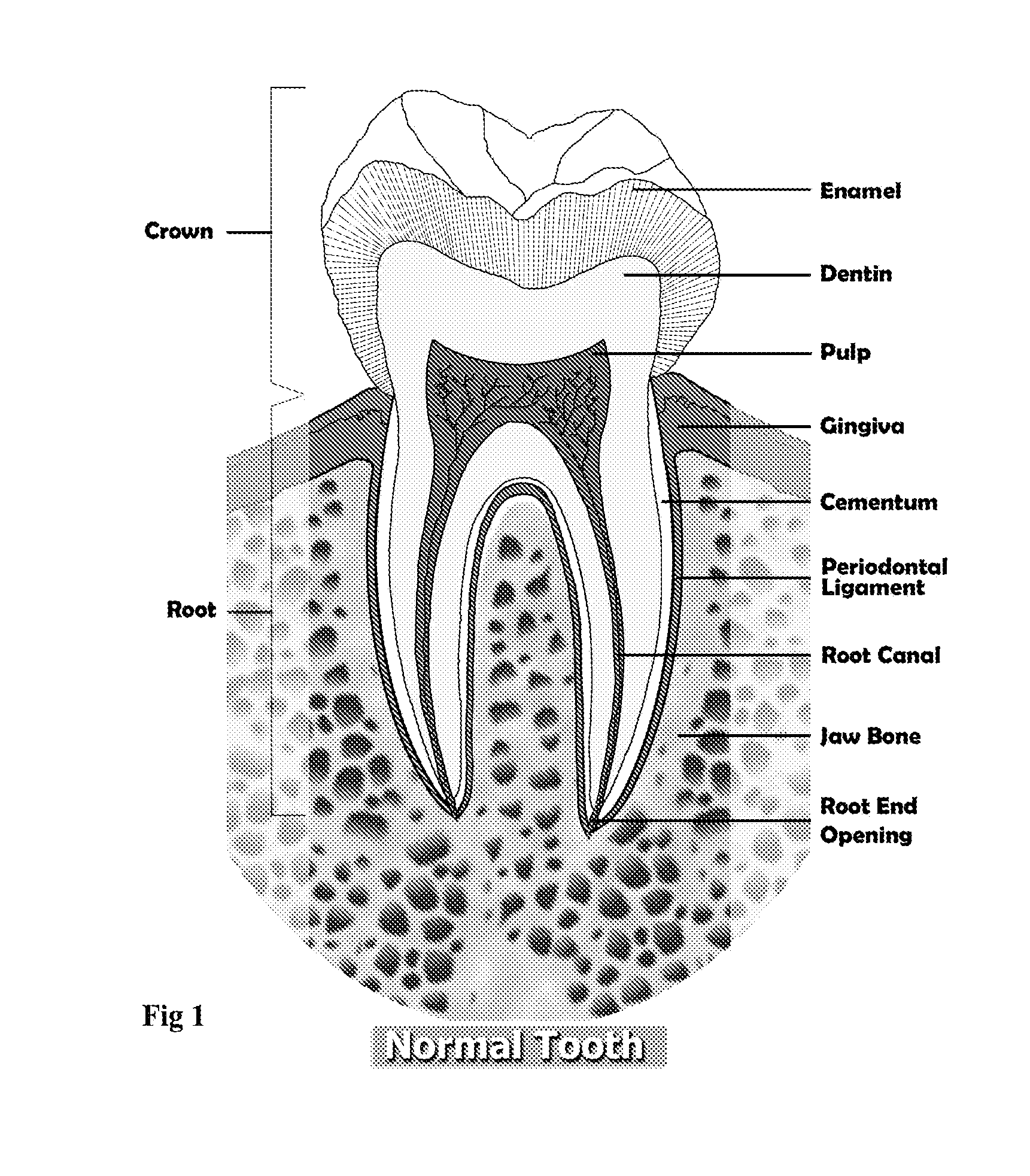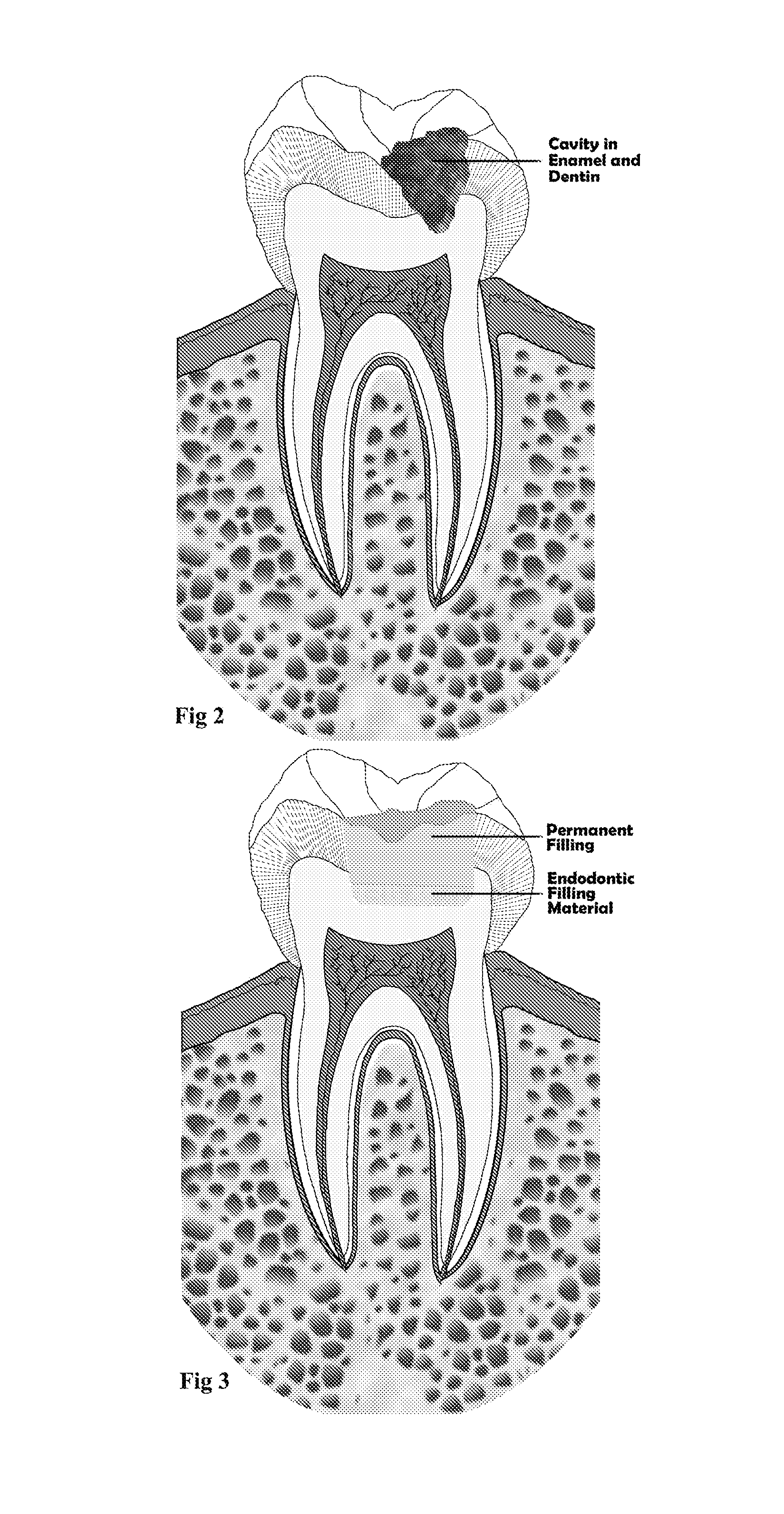Endodontic filling material
a filling material and endodontic technology, applied in the field of biomaterials, can solve the problems of incompatibility of materials, complete and tridimensional seal of the root canal system, and inability to achieve a satisfactory seal. achieve the effect of improving the seal
- Summary
- Abstract
- Description
- Claims
- Application Information
AI Technical Summary
Benefits of technology
Problems solved by technology
Method used
Image
Examples
example one
[0066]The preferred embodiment of the present endodontic filling material in this example has the following powder and liquid compositions:
A) Powder:
[0067]Tricalcium silicate and dicalcium silicate (61%), barium sulfate (14%), tricalcium phosphate and dicalcium phosphate (8%), calcium sulfate (5%), calcium hydroxide (5%), calcium oxide (2%), calcium aluminate (2%), calcium carbonate (2%), and calcium chloride (1%).
B) Liquid:
[0068]The liquid was a phosphate buffer saline solution of the following composition: 1.7 g KH2PO4, 11.8 g Na2HPO4, 80.0 g NaCl, and 2.0 g KCl in 10 liters of distilled water (pH—7.2).
[0069]According to the present invention, the use of the endodontic filling material provided an effective means for pulp capping agents and procedures. In order to determine these capabilities, a study was procedures as follows: a cavity preparation is made in each of the eight animal teeth. During the preparation, exposure of the pulp occurred. Control of bleeding is accomplished ...
example two
[0071]The powder and liquid compositions in this example are as follow:
A) Powder:
[0072]Tricalcium silicate and dicalcium silicate (48%), tricalcium phosphate and dicalcium phosphate (18%), barium sulfate (15%), calcium hydroxide (6%), calcium sulfate (6%), calcium oxide (3%), calcium carbonate (2%), calcium fluoride (1%), and calcium aluminate (1%).
B) Liquid:
[0073]The liquid was a normal saline solution of the following composition: 9.0 g NaCl in 1 liters of distilled water.
[0074]The performance of the endodontic filling material with the above composition was evaluated for root-end filling using dye penetration method. This method of measuring the sealing ability of root-end filling materials is well known. In dye penetration test, the root-end cavity is first prepared and then filled with the material to be tested. This test allows a comparison (under controlled conditions) between the sealing ability of standard filling materials, such as MTA, and the cement composition of the pr...
example three
[0077]The powder and liquid compositions in this example are as follow:
A) Powder:
[0078]Tricalcium silicate and dicalcium silicate (40%), tricalcium phosphate (20%), barium sulfate (18%), calcium sulfate (8%), calcium oxide (6%), calcium carbonate (4%), calcium hydroxide (3%), and calcium fluoride (1%).
B) Liquid:
[0079]The liquid was a phosphate buffer saline solution of the following composition: 1.7 g KH2PO4, 11.8 g Na2HPO4, 80.0 g NaCl, and 2.0 g KCl in 10 liters of distilled water (pH—7.2).
[0080]Based on the present invention, the use of the endodontic filling material, provided an effective additional seal_second seal_for the most outer area of the root-end filling material and the surrounding dentin, via its ability of hydroxyapatite crystal formation, so that a hydroxyapatite cap blocked the communication path between root canal system and periradicular area by its adhesion to the material and surrounding dentine the both. The study design for the evaluation of this ability was...
PUM
| Property | Measurement | Unit |
|---|---|---|
| angle | aaaaa | aaaaa |
| concentration | aaaaa | aaaaa |
| pH | aaaaa | aaaaa |
Abstract
Description
Claims
Application Information
 Login to View More
Login to View More - R&D
- Intellectual Property
- Life Sciences
- Materials
- Tech Scout
- Unparalleled Data Quality
- Higher Quality Content
- 60% Fewer Hallucinations
Browse by: Latest US Patents, China's latest patents, Technical Efficacy Thesaurus, Application Domain, Technology Topic, Popular Technical Reports.
© 2025 PatSnap. All rights reserved.Legal|Privacy policy|Modern Slavery Act Transparency Statement|Sitemap|About US| Contact US: help@patsnap.com



